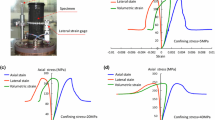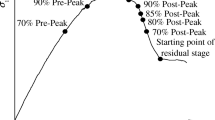Abstract
A technique for interpreting rock specimen compression testing data is proposed. It consists of mathematical modeling of the loading of a specimen containing the sliding line L, on which the stresses are continuous and the displacements are discontinuous. At each step of loading the values of a jump of displacements on L are found from the experimentally known stress-strain dependences. The empirical relations describing the strain process on the sliding line are found using these results. Based on Stavrogin's experimental data, we estimate the parameters of the dependence of the peak strength of the interblock contact on the shift from the normal stress.
Similar content being viewed by others
References
M. A. Sadovskii, L. G. Bolkhovitinov, and V. F. Pisarenko,Deformation of the Medium and the Seismic Process, [in Russian], Nauka, Moscow (1987).
A. N. Stavrogin and A. G. Protosenya,Mechanics of Rock Deformation and Fracture [in Russian], Nedra, Moscow (1992).
A. N. Stavrogin and B. G. Tarasov, “Some results obtained with high-stiffness rock testing systems,”News J. Int. Soc. Rock Mech.,3, No. 2, 7–19 (1995).
N. R. Barton, “Deformation phenomena in jointed rock,”Geotechnique,36, No. 2, 147–167 (1986).
N. R. Barton and V. Choubey, “The shear strength of rock joints in theory and practice,”Rock Mech.,10, 1–54 (1977).
K. Bock (ed.),Introduction to the Mechanics of Jointed Rock [Russian translation], Mir, Moscow (1983).
A. F. Revuzhenko and E. I. Shemyakin, “Formulations of the boundary-value problems ofL-plasticity,”Prikl. Mekh. Tekh. Fiz., No. 2, 128–137 (1979).
A. F. Revuzhenko, “Variational formulations of boundary-value fracture problems,”Prikl. Mekh. Tekh. Fiz., No. 4, 148–156 (1980).
A. A. Baraykh and A. S. Gegin, “Evaluation of the stability of interchamber pillars”Fiz. Tekh. Probl. Razrab. Polezn. Iskop., No. 1, 30–38 (1997).
L. Jing, O. Stephansson, and E. Nordlund, “Study of rock joints under cyclic loading conditions,”Rock Mech. Rock Eng.,26, No. 3, 215–232 (1993).
W. Wittke,Rock Mechanics, Springer-Verlag, Berlin (1990).
S. Bandis, A. C. Lumsden, and N. A. Barton, “Experimental studies of scale effects on the shear behavior of rock joints”Int. J. Rock Mech., Min. Sci. Geomech. Abstr.,18, No. 1, 1–21 (1981).
Additional information
Mining Institute, Siberian Division, Russian Academy of Sciences, Novosibirsk 630091. Translated from Prikladnaya Mekhanika i Tekhnicheskaya Fizika, Vol. 39, No. 6, pp. 142–147, November–December, 1998.
Rights and permissions
About this article
Cite this article
Nazarov, L.A., Nazarova, L.A. Determination of the strain characteristics of interblock contacts using rock specimen testing results. J Appl Mech Tech Phys 39, 943–948 (1998). https://doi.org/10.1007/BF02468228
Received:
Issue Date:
DOI: https://doi.org/10.1007/BF02468228




